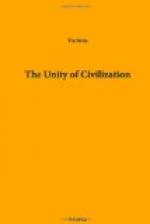Race, indeed, in Europe, as well as further afield, has been anything but a factor of unity. When we speak (on platforms) of Europeans as ‘white men’, we are in danger of forgetting, what every practical man in our audience knows, that we are dealing with at least three distinct breeds of mankind, which agree, indeed, rather imperfectly in the whiteness of their skin, but differ greatly in other points of structure and physique, including resistance to certain types of climate and regional diseases, and not least in temperament and the quality of their response to Nature’s challenges of hardship or indulgence. Of these three breeds of man, only one, the blond Boreal giants (the only ’white men’ in the strict sense of defect of pigment in skin, hair, and eyes) is exclusively European now, and has his habitat within the area of the ‘Boreal’ groups of animals and plants. His champions in ethnological propaganda seem to be of two minds about his earlier distribution; either his ‘home’ was round the Baltic, in which case it is difficult to see why he should be represented as a civilizing agency, in view of the cultural backwardness of that region; or else it was out on the Eurasian grassland, in which case he is as much an intruder into peninsular Europe as his brachycephalic ‘Alpine’ rival, and his claim to represent indigenous European man must go. The large part which he has played in European history seems to result partly from his great physical strength, surpassed (I believe) only by that of the Negro, partly from his reluctance, not so much to interbreed with more pigmented strains, but to admit the crossbred offspring to full partnership with himself. Even among his like, he has his own criteria by which one ‘white man’ knows another, and coheres with him politically.
Most strongly contrasted externally with the ‘Boreal’ type is the slight-built Mediterranean brunet. That his home is in the south, that he is closely related with the men of the African and Arabian grasslands, and that he was among the first post-glacial explorers of the Atlantic seaboard, is admitted. More doubt arises as to the extent to which he penetrated from these southern and western bases into the heart of peninsular Europe. Certainly as we trace him to the south-east he seems more and more restricted to the Mediterranean coastline, and at last has no early monopoly even of the islands. The contrast between Crete and Cyprus is instructive as to this. The ‘Mediterranean’ type, in fact, reaffirms to the anthropologist the close zoological affinity between South-west Europe and North-west Africa.




